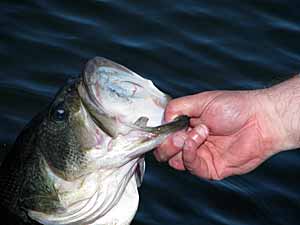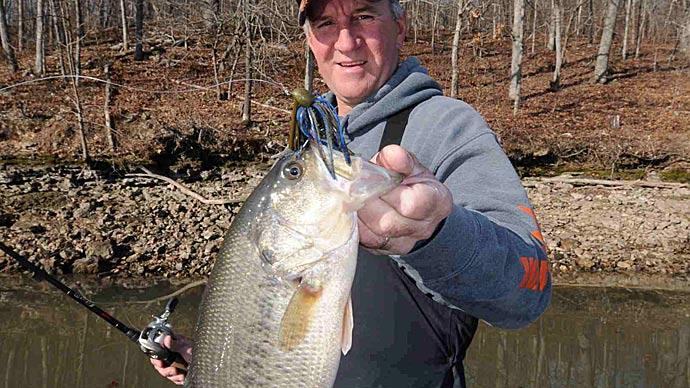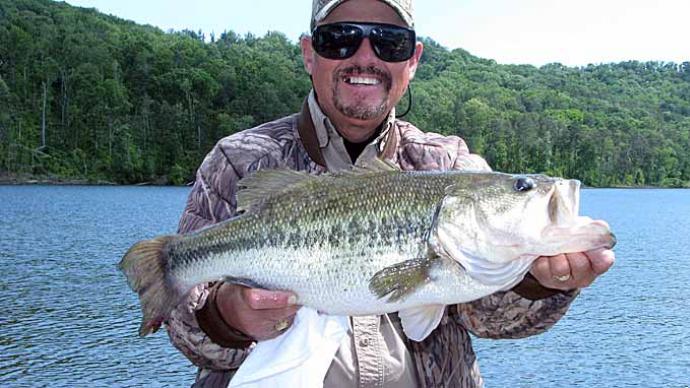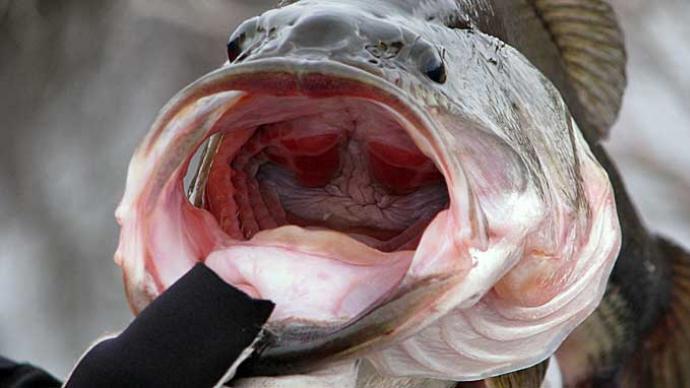
Many years ago, when I first contacted Bob Crupi (the only person to have two bass over twenty pounds on the I.G.F.A record books), he left me with many new ideas. Ideas, if practiced consistently over time, would help me or anyone else catch bigger fish. One such idea that stands out is to SLOW DOWN my presentation. Bob said that from a swim bait to an 18-inch worm to a live crawdad, S L O W D O W N.
BIG BASS did not have the impulse to have a reactionary strike on a bait, like a smaller fish. As the BIG BASS grow older, larger, and wiser, they tend to eat when they want and will not "react." John Deckard calls this a "distinction." BIG BASS have a distinction that they will not eat something that flies by them. Going 100 mph in a school zone will not work on BIG BASS.
Think about it for a moment . . are you rushed on your way to the lake? Are you running late? Do you fly into Starbucks or 7/11 and get an extra large, extra caffeinated coffee? Can't wait to get there and get launched? When the launch ramp gets crowded, do you start honking the horn at some inexperienced fishing enthusiast? You're so hurried and "fueled" by your self-imposed adrenaline rush that your presentation breaks the sound barrier when it comes time to fish. But that's okay . . . , they told you to "burn" the spinnerbait or "turbo-retrieve" the buzzbait so it leaves a jetwash that would make an FA/18 Hornet jealous. This is how many fishing enthusiasts "set up" for their fishing experience.
Now, don't get take me out of context here. Yes, there are times when these techniques mentioned above are called for. Yet, in most cases, when on the hunt for BIG BASS, they will turn their noses up at you and think that they just might be occupying the safest place in the lake.
Crupi, when first learning about bass fishing, lived on Long Island, New York. Bob told me that when he caught his very first bass, he placed it in an aquarium and watched its habits. He learned many things by watching and feeding it. He gave it worms, crickets, crawdads, small minnows, and feeder fish. As a result, he could see firsthand what these natural baits did and how slowly they moved. Likewise, in my aquarium, a crawdad or nightcrawler moves so slowly that it sometimes gets boring to watch. Yet, they are giving us clues . . . clues to slow down our presentations.
So, S L O W D O W N by following these pointers:
Chuck Bauer's Pointers
- Present your baits just like you were driving your car through a school zone, and a police officer was standing outside his patrol car and had the radar gun trained on you.
- Visually imagine what a "natural" presentation would look like.
- Practice casting your baits in a swimming pool and see how they work. Unfortunately, your bathtub or kitchen sink isn't a proving ground.
- Invest in a 10-gallon aquarium with an aerator. Place all kinds of "live" bait (worms, bluegill or perch, minnows, crawdads, waterdogs, feeder goldfish, etc.) in your aquarium and observe daily. Place a small bass in the tank and observe as well.
- Slowing down gives you versatility and another "tool" to use.
- Take 500mg of patience before your trip. If you are high on the adrenaline chart, take 500mg before every cast!
- Slow down on the trolling motor. It's not a qualifying engine for a N.A.S.C.A.R. race.
- On the way to the lake, go into silent time and think about slowing down.
- Commit to SLOWING DOWN. Don't give up on it after only trying it for ten minutes. A habit takes about 20-30 days to form, so be patient with yourself.
- Break your adrenaline habit by working a 12-inch or longer worm (I have some 18 inches in length) or stitching when you are Carolina rigging, as Bill Murphy states in his book, "Stitch" the bait back to the boat. Some of these stitching retrievals from one cast may take ten minutes or more! But stitching might be one of the most effective BIG BASS techniques known to mankind.
Know that just being aware of slowing down and that you'll need to be more patient means that half the battle has already been won. Awareness is the BIG first step. Breaking the habit is second. Making it a new habit is third.
When I teach goal-setting seminars, I share with the audience members that each goal must have an identifiable benefit and consequence. That means if you reach your goal, you have earned the benefit. However, on the flip side, if you don't reach your goal, you must suffer the consequence.
In slowing down your fishing presentations, you now move towards the goal of bangin' BIGGER BASS. You place the advantage towards you. Yet, if you stay with the same adrenaline-based presentation, your chances of bangin' a BIG BASS are extremely diminished—benefit vs. consequence.
Kinda reminds me of the very famous "Insanity" quote. It goes something like this . . . "Keep doing what you've been doing . . . and expect things to change." That, my friends, is the definition of INSANITY.
So, change things up, and S L O W D O W N. Keep after it and keep the vision of that BIG BASS clear in your mind. Who knows . . . maybe someday we'll hear bout' YOUR ten pounder!
Chuck Bauer is a noted Big Bass Specialist who has been recognized many times by various organizations, including Bassin' Magazine, Texas Fish & Game, North American Fisherman Magazine, Outdoor Life, Texas Hunting and Fishing News, The Dallas Morning News, and Texas Outdoor Times Magazine. In addition, Chuck is a Professional Member of the National Speakers Association and is on Pro Staff for Kick-n-Bass.
Chuck also does free fishin' seminars in and around the Dallas/Ft. Worth Metroplex.




